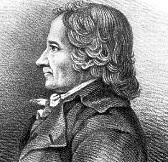
Johann Albert Fabricius was a German classical scholar and bibliographer.

Girolamo Fabrici d'Acquapendente, also known as Girolamo Fabrizio or Hieronymus Fabricius, was a pioneering anatomist and surgeon known in medical science as "The Father of Embryology."

Johan Christian Fabricius was a Danish zoologist, specialising in "Insecta", which at that time included all arthropods: insects, arachnids, crustaceans and others. He was a student of Carl Linnaeus, and is considered one of the most important entomologists of the 18th century, having named nearly 10,000 species of animals, and established the basis for the modern insect classification.

Pentatomidae is a family of insects belonging to the order Hemiptera, generally called shield bugs or stink bugs. Pentatomidae is the largest family in the superfamily Pentatomoidea, and contains around 900 genera and over 4700 species. As hemipterans, the pentatomids have piercing sucking mouthparts, and most are phytophagous, including several species which are severe pests on agricultural crops. However, some species, particularly in the subfamily Asopinae, are predatory and may be considered beneficial.

In zoological nomenclature, a type species is the species name with which the name of a genus or subgenus is considered to be permanently taxonomically associated, i.e., the species that contains the biological type specimen(s). A similar concept is used for suprageneric groups and called a type genus.

Fabricius is a lunar impact crater that is located within the northeast part of the walled plain Janssen. Attached to the north-northwest rim is the slightly larger crater Metius. Fabricius has multiple central peaks that rise to 0.8 km, with a rugged rise to the northwest running north–south. The rim is lumpy and somewhat distended, most noticeably to the southwest and south. It is 78 kilometers in diameter and 2,500 meters deep. It is from the Eratosthenian period, 3.2 to 1.1 billion years ago. It is named after David Fabricius, a 16th-century German astronomer.

The Pons Fabricius or Ponte dei Quattro Capi, is the oldest Roman bridge in Rome, Italy, still existing in its original state. Built in 62 BC, it spans half of the Tiber River, from the Campus Martius on the east side to Tiber Island in the middle. Quattro Capi refers to the two marble pillars of the two-faced Janus herms on the parapet, which were moved here from the nearby Church of St Gregory in the 14th century.

The Pons Cestius is an ancient Roman bridge connecting the right bank of the Tiber with the west of the Tiber Island in Rome, Italy. In Late Antiquity, the bridge was replaced and renamed the Pons Gratiani. It is also known as Ponte San Bartolomeo. No more than one third of the present stone bridge is of ancient material, as it was entirely rebuilt and extended in the 19th century, after numerous earlier restorations.

Glossata is the suborder of the insect order Lepidoptera that contains most lepidopteran species and includes all the superfamilies of moths and butterflies that have a coilable proboscis..

Otto Fabricius was a Danish missionary, naturalist, ethnographer, and explorer of Greenland.

Johann Philipp Fabricius was a German Christian missionary and a Tamil scholar in the later part of his life. He arrived in South India in 1740 to take charge of a small Tamil Lutheran congregation in Madras and expanded it during his stay. During his time in Madras he wrote several Christian hymns in Tamil and published the first Tamil to English Dictionary. Of his works his translation of the Bible to Tamil is considered to be most noteworthy.

Saperda is a genus of flat-faced longhorn beetles belonging to the family Cerambycidae, subfamily Lamiinae. The genus was erected by Johan Christian Fabricius in 1775.

Morphini is a tribe of nymphalid butterflies in the subfamily Morphinae.

Caerois chorinaeus is a butterfly of the family Nymphalidae. It was described by Johan Christian Fabricius in 1775. It is found in Suriname, the Guianas and Peru.

Earth Sick is the fourth studio album by Danish recording artist Oh Land. It was released on 11 November 2014 by her independent label Tusk or Tooth.
Camilla Fabricius is a Danish politician, who is a member of the Folketing for the Social Democrats political party. She was elected into parliament at the 2019 Danish general election.
















